 If that wasn't scary enough,
then I gave my students thirteen inequations
in three variables and tasked them to build
a physical, three-dimensional model of the
polytope that satisfied all of them.
If that wasn't scary enough,
then I gave my students thirteen inequations
in three variables and tasked them to build
a physical, three-dimensional model of the
polytope that satisfied all of them.
|
A: x ≧ 0
B: y ≧ 0 C: z ≧ 0 D: 55x−13y+77z ≦ 539 E: −7x+2y−14z ≦ 14 F: 8x+2y+4z ≦ 64 G: 3x+9y−8z ≦ 78 H: −24x+12y+36z ≦ 252 I: 1x−2y−1z ≦ 9 J: −3x+6y−2z ≦ 42 K: −4x−2y−z ≦ 0 L: 9x+3y+z ≦ 75 |
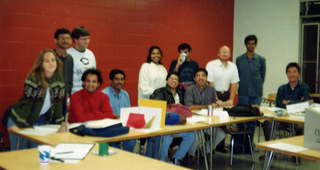 I explained that in the early days of machining metal
students were given a rock of steel
(no stainless in those days),
a hacksaw, and a file
and they were tasked to make a cube
one inch on a side plus-or-minus
one-thousandth of an inch.
This way they would learn what the fancy tools in the shop
were doing for them.
One of them said he had nightmares of
polygons chasing him in the night.
I explained that in the early days of machining metal
students were given a rock of steel
(no stainless in those days),
a hacksaw, and a file
and they were tasked to make a cube
one inch on a side plus-or-minus
one-thousandth of an inch.
This way they would learn what the fancy tools in the shop
were doing for them.
One of them said he had nightmares of
polygons chasing him in the night.
I didn't expect them to get all of it, but I wanted them to struggle and to understand the struggle. To share their challenge, I didn't actually do the assignment until after I gave it to them, then I wrote my own computer program that generated a plot that I could cut out and make into the polytope required.
It was an adventure for me. I've given oodles of talks and lectures, an hour of exposition on some subject, where the implicit promise is that the subject matter included is true and relevant. The way I put it is that a course promises something more, a sense of completeness, that the subject matter not included is not true or irrelevant. A course on mathematical programming should cover the field an introductory course should introduce all the important issues.
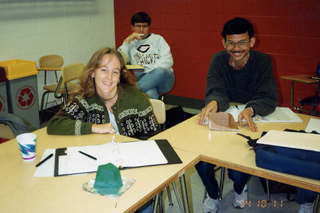 I was given a three-hour time slot once a week,
so I introduced myself my first lecture
and spent an hour doing a
two-variable-two-constraint linear maximization
in plain algebra, no fancy matrix notation,
just high-school-level stuff.
I spent the second hour having my students
introduce themselves and answer the standard question,
"Why are you taking this course?"
Then I spent the third hour doing a different
two-variable-two-constraint linear minimization
in the same tedious, trivial notation.
At the end I stood back and pointed out
that all the coefficients in the maximization problem were
the same as the coefficients in the minimization problem,
step by step,
even though the problems were quite different.
This is how I introduced the concept of
linear-program duality that is the core
of math programming.
I was given a three-hour time slot once a week,
so I introduced myself my first lecture
and spent an hour doing a
two-variable-two-constraint linear maximization
in plain algebra, no fancy matrix notation,
just high-school-level stuff.
I spent the second hour having my students
introduce themselves and answer the standard question,
"Why are you taking this course?"
Then I spent the third hour doing a different
two-variable-two-constraint linear minimization
in the same tedious, trivial notation.
At the end I stood back and pointed out
that all the coefficients in the maximization problem were
the same as the coefficients in the minimization problem,
step by step,
even though the problems were quite different.
This is how I introduced the concept of
linear-program duality that is the core
of math programming.
In subsequent classes I derived the basics of linear programming for my students with stories from my own work. The middle hour was devoted to having them present their work on the homework problems for two reasons. First, this is a "doctoral level" course and one of the requirements of a Ph.D. degree, at least one of my requirements, is being able to present material to an audience. Second, even I find my own voice tiresome for three hours straight.
One student had a terrible time the first time he had to present his results to the class. They tell me that death is Number-Two on the list of people's most-feared events with public speaking being Number-One. He shook and trembled and got through it and, I heard from a friend on the faculty, he was thrilled "Professor Rosenberg was supportive and helpful" and he was able to get through it. A feared challenge became a proud accomplishment.
I had one of those moments any teacher dreads. I was explaining the basis-change equations of the Simplex Method and realized I didn't remember one formula, the constant term on the lower right. I hemmed and hawed for about thirty seconds, turned to face the class, and admitted I didn't remember this. "I'll finish this part next time," I told them and I did that. I like to think they respected me more for my mistake and recovery than they did before. Professor Rosenberg is human after all.
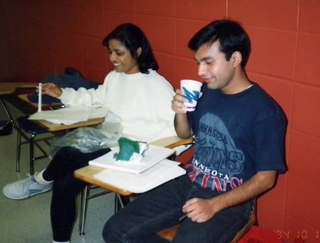 When John Nash got the Nobel Prize for his work in 1950
I took time out from the regular curriculum to explain
who he was and what he accomplished.
For those who were dragged through the awful exposition
in the movie "A Beautiful Mind," let me explain it better.
I'll put the explanation in small type
so the less-interested reader can skip it.
When John Nash got the Nobel Prize for his work in 1950
I took time out from the regular curriculum to explain
who he was and what he accomplished.
For those who were dragged through the awful exposition
in the movie "A Beautiful Mind," let me explain it better.
I'll put the explanation in small type
so the less-interested reader can skip it.
Suppose I have a two-person game that is "zero sum" so anything one player gets the other loses. Think of Rock-Paper-Scissors where the loser pays the winner one dollar. Any single-choice "pure" strategy can be beaten by the correct choice, so the worst-case scenario isn't good. The optimal strategy is a "mixed" strategy with probabilities of one-third for each choice. No pure strategy and no mixed strategy can beat a worst-case average payout of zero in this game.
Even in the RPS-Professional league (wink) where ties are resolved by subsequent rock-paper-scissors rounds the optimal plan is still a mixed one-third-one-third-one-third strategy.
In 1927 John von Neumann proved that a two-person, zero-sum game like this has strategies for both players so that each can guarantee average outcomes that are negatives of each other, no "duality gap" between them. In this case both sides can guarantee breaking even.
In 1950 John Nash extended this notion of a game equilibrium to games with more than two players and games that are not zero sum. One such example, once Tic-Tac-Toe, Odds-Evens, and Rock-Paper-Scissors are settled, would be Global Thermonuclear War where some outcomes are decidedly better than others for everybody in the game.
Nash showed there was always a set of strategies for all the players where no player can improve his own expected outcome by changing strategy. That doesn't mean there isn't a solution better for some or all players, only that there is an equilibrium, "pareto-optimal" solution.
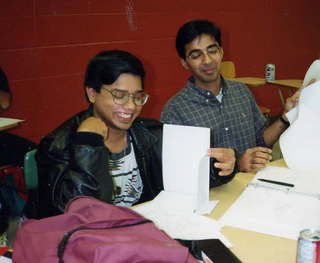 I recall some intersesting proofs using Sperner's lemma
to prove the Brouwer fixed point theorem which proves
Kakutani's fixed point theorem that proves Nash's result.
I did not drag my class through all that,
but I felt the importance of Nash and his work
was an fundamental part of mathematical programming.
I recall some intersesting proofs using Sperner's lemma
to prove the Brouwer fixed point theorem which proves
Kakutani's fixed point theorem that proves Nash's result.
I did not drag my class through all that,
but I felt the importance of Nash and his work
was an fundamental part of mathematical programming.
While I never actually met John Nash, I remember seeing him walking in the snow in his shorts and sneakers around Fine Hall at Princeton University. His best friend for most of his life was Forman Acton, a dear friend of mine for nearly forty years, so I was apprised of Dr. Nash's life story. I sat on the desk one class and told the story of John Nash including his equilibrium theorem and his schizophrenia and how much of a challenge it would be to accept the Nobel Prize. One of the requirements of winning the Prize is to explain the invention or discovery to the King of Sweden. There are thousands of math geeks who could easily explain the Nash Equilibrium Theorem, even to a lay audience, but, after years of mental illness, John Nash was not one of them. I assume he had plenty of coaching from his friends at Princeton University for the trip.
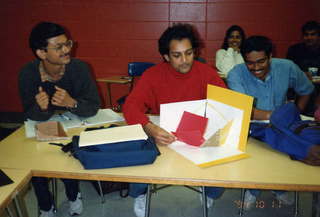 Around the linear-programming Simplex Method
using extreme points of polytopes
there were stories of Leonid Khachiyan's ellipsoids
and Narendra Karmarkar's interior-point algorithm,
both of which happened in my own professional lifetime.
Somehow The New York Times
permuted and perverted the story they were given
to get to the totally wrong conclusion
that Khahiyan's work meant the Russians
could break our secret codes, totally wrong in several ways.
Around the linear-programming Simplex Method
using extreme points of polytopes
there were stories of Leonid Khachiyan's ellipsoids
and Narendra Karmarkar's interior-point algorithm,
both of which happened in my own professional lifetime.
Somehow The New York Times
permuted and perverted the story they were given
to get to the totally wrong conclusion
that Khahiyan's work meant the Russians
could break our secret codes, totally wrong in several ways.
They also learned about Dantzig-Wolfe decomposition, Kuhn's "Hungarian Algorithm," Kuhn-Tucker points and their exception cases, which I learned about from George Dantzig at Stanford and Harold Kuhn at Princeton so I can claim some level of authority. It was a lot of fun for me and, from what I'm told, a challenging adventure for my class.
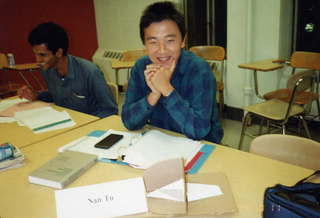 My students learned to program in AMPL
(A Mathematical Programming Language)
written by Bob Fourer, David Gay,
and Brian Kernighan.
I've met all three and went to graduate school with Bob.
My students learned to program in AMPL
(A Mathematical Programming Language)
written by Bob Fourer, David Gay,
and Brian Kernighan.
I've met all three and went to graduate school with Bob.
Well, I gave a truly-challenging final exam with an example of "the cutting-stock problem" which was new enough not to be in textbooks, so they had really to understand that material in the course. All of them got more than 90% on the exam and I turned in a grade sheet with eleven A grades.
One of my students was clearly struggling with a language-barrier and a half-time job, so I went to campus an extra night per week and coached him over dinner. I was very proud when he earned his A on my final exam.
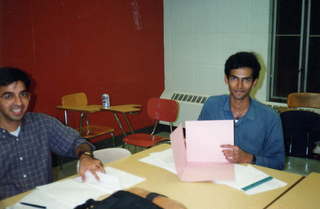 When I called the department head,
concerned about the impression I succumbed to grade-inflation,
he said not to worry.
"I saw your final exam."
He figured anybody getting 90% on that exam knew the stuff.
I even got stellar reviews from the students in the class.
When I called the department head,
concerned about the impression I succumbed to grade-inflation,
he said not to worry.
"I saw your final exam."
He figured anybody getting 90% on that exam knew the stuff.
I even got stellar reviews from the students in the class.
I'm proud to say I'm still in touch with two of my eleven students and I'm proud of the work they have done. One of them invited me to his wedding in Madras, India, in 1998, my first trip to Asia and a wonderful moment in my life. The other just started a job at Clear Demand, the company I founded with two partners in 2012. I would say my eighteen years of fantasizing over how I would teach this course resulted in an overwhelming success.
I also recall that 1994 was the prettiest leaf-turning autumn in my Minnesota experience and I was running a lot of farm-country dirt roads, so that time was an extra pleasure for me.
|
8:59:02 Mountain Standard Time (MST). 397 visits to this web page. |